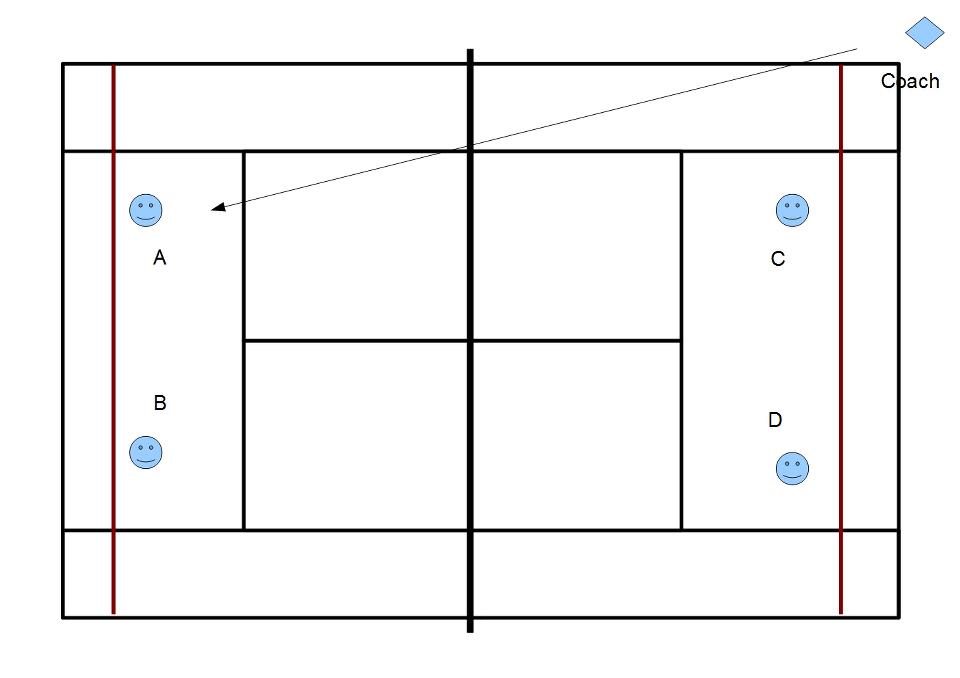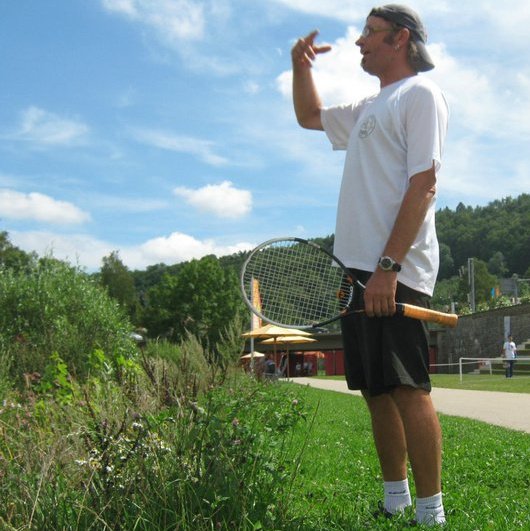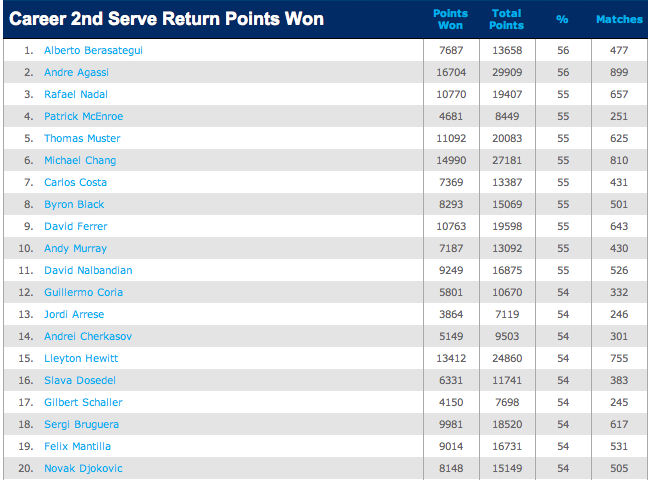 ...or are crazy people attracted to tennis?" I recall my friend asking me this question. It was 120 degrees Fahrenheit in Palm Springs and we had been grinding for hours. We could literally fry eggs on a hot plate placed in the sun. During a routine water break we started discussing all the seemingly abnormal people that we met through tennis: one guy riding his bicycle down the street with singles-sticks in his backpack (because it drove him nuts to play tennis without singles sticks) - this, incidentally, was the same guy who decided, in a middle of a lesson that he was giving, that he was hungry and simply left his student on the court and never came back; another character attempting to stage fights between black widows and scorpions for his own (but nobody else's) amusement (OK, I was amused a little); another living in his van and driving around from open tournament to open tournament for the better part of a decade in the hopes of eventually "making it;" then there were the people who went through more tennis rackets than Marat Safin at the slightest on-court discomfort. All these personalities were highly accomplished players...and all of them were a bit...off.
...or are crazy people attracted to tennis?" I recall my friend asking me this question. It was 120 degrees Fahrenheit in Palm Springs and we had been grinding for hours. We could literally fry eggs on a hot plate placed in the sun. During a routine water break we started discussing all the seemingly abnormal people that we met through tennis: one guy riding his bicycle down the street with singles-sticks in his backpack (because it drove him nuts to play tennis without singles sticks) - this, incidentally, was the same guy who decided, in a middle of a lesson that he was giving, that he was hungry and simply left his student on the court and never came back; another character attempting to stage fights between black widows and scorpions for his own (but nobody else's) amusement (OK, I was amused a little); another living in his van and driving around from open tournament to open tournament for the better part of a decade in the hopes of eventually "making it;" then there were the people who went through more tennis rackets than Marat Safin at the slightest on-court discomfort. All these personalities were highly accomplished players...and all of them were a bit...off.
BEFORE PROCEEDING, IT IS IMPORTANT TO NOTE THE FOLLOWING: CATENNIS.COM IS NOT IN THE "BUSINESS" OF DISPENSING PSYCHIATRIC OR PSYCHOLOGICAL ADVICE. TAKE THE FOLLOWING INFORMATION WITH A GRAIN OF SALT AND PERFORM YOUR OWN DUE DILIGENCE.
I was reminded of the foregoing episode as I ran across an article entitled Standoffish Perhaps, but Successful As Well: Evidence That Avoidant Attachment Can Be Beneficial in Professional Tennis and Computer Science (J. Pers. 2011 Aug 3, Ein-Dor, T.; Reizer, A.; Shaver, PR; and Dotan, E.). Initially, we thought to ourselves: "so nice guys do finish last; jerks always get the girl. Sweet!" On a more serious note, however, people who are described as being "standoffish" or, in professional terms, attachment-avoidant share some of the following characteristics: dismissive state of mind with respect to attachment; avoid intimacy and close affective involvement; early caregivers were either unnurturing, dismissive or critical; emotionally distant, cool, controlled, ambitious and successful; tend to be sarcastic and/or passive aggressive; do not want to rely on anyone; fear dependency. Briefly, "dismissive avoidant individuals claim to be comfortable without close relationships and appear to be indifferent to how other people think of them," No man is an island: the need to belong and dismissing avoidant attachment style (Pers. Soc. Psychol. Bull., 2006 May Carvallo, M.; Gabriel, S.). See also, Temperament, childhood environment and psychopathology as risk factors for avoidant and borderline personality disorders (Aust. NZ J Psychiatry, 2003 Dec; Joyce, PR; McKenzie JM; Luty SE; Mulder JD; Sulliva PF; Cloinnger, CR) where it was noted that "avoidant personality disorder can be conceptualized as arising from a combination of high harm avoidance (shy, anxious), childhood and adolescent anxiety disorders and parental neglect."
Initially, Ein-Dor et. al state that attachment-avoidance personality style (i.e., characteristics that outline how a person relates to other people) has been associated with "poorer adjustment in various social, emotional, and behavioral domains." However, when it comes to tennis individuals exhibiting these traits appear to be "better equipped than their less avoidant peers to succeed and be satisfied". As the researchers state, "these fields [tennis and computer science] may reward self-reliance, independence, and the ability to work without proximal social support from loved ones." As part of the research, 58 top professional singles players were followed for 16 months and those who scored highest in the avoidance attachment personality tended to have "a higher ranking, above and beyond the contributions of training and coping resources."
On surface level, and from a layperson's point of view, the findings appear to make sense: attachment-avoidant personalities often fail to recognize their own admirable qualities and, unless they shy away from the sport completely, work hard to perfect their game. We call these people "perfectionists" and, often times, admire and idolize them for their drive and work ethic. Furthermore, tennis, as a sport, is fairly anti-social. With an opponent, coach and training partner on the other side of the net, the opportunity for interpersonal contact is limited. At first blush, attachment-avoidants may be perfectly suited for this type of a sport: lots of individual workouts; no interaction with team-mates or even opponents; coaches and parents kept at a safe distance behind the fence (and windscreens); traveling by oneself; etc.
On the other hand, is there a possibility that otherwise "normal" people may develop this personality style by being immersed in the game (and the individual practices, workouts and matches that go along with it) - nature versus nurture? That is, can pushing someone to be too independent lead to not only undesirable psychological conditions but also have negative consequences in athletic competition? For example (and somewhat in contrast to the principal article), in Intrapersonal and interpersonal factors in athletic performance (Scand. J. Med Sci. Sports, Aug. 1995; Iso-Ahola, SE), the researcher hypothesizes that successful athletic performanceis a function of intrapersonal (intrinsic motivation) and interpersonal (social support) factors. The article concludes that "[m]aximization of psychological conditions for successful performance requires that coaches foster athletes' intrapersonal and interpersonal psychosocial resources by serving as facilitators of their autonomous self-regulation rather than as controllers of their goals and behaviors." That is, in order for an athlete to be successful (and capable of adequately handling athletic life and stresses) as complete suport network is necessary and the coach plays an integral role in making sure that an adequate balance is struck.
Anecdotal evidence is also provided by an acquitance of CAtennis.com (who, for purposes of this article, has elected to remain anonymous) who has, in his capacity as 30+ year licensed sports psychologist, worked with a variety of world-class athletes including tennis players, golfers, football, basketball and baseball players. Our contact has confirmed that, from his professional experiences, the vast majority of his clients can be described by laypeople as being "anti-social." Several of these athletes find more solace in their sport than in their personal relationships (family, spouses, coaches and even caddies). That is, their respective sports make these athletes feel complete (passion for the sport transcends any feeling they have toward "loved ones"). Perhaps, the sport is the only constant in the lives of these athletes thereby serving as the "missing piece". Insert reference to The Red Violin (character sleeping with the violin in his bed) or Keith Richards (admitting to sleeping next to his guitar so that he could "breathe it in") here. In some extreme cases, the sport is their only escape from psychic pain which causes them to live in the past ("glory days") or in fantasy without being capable of progressing to the next stage in life. But, again, we are talking about very successful athletes here.
Nevertheless, none of this should be interpreted by parents or coaches as constituting a license to abuse (physically or mentally) or neglect the child in pursuit of glory; Pandora's box may contain unintended consequences and it's doubtful that the ultimate prize ("making it") is worth the lifetime of psychological and interpersonal issues. Becoming attachment-avoidant is not, and should not be construed as being, a guarantee of success.
However, both the study and the anecdote seem to suggest that a handful of traits go hand-in-hand with certain levels of success. For example, being "independent", "internally motivated", "driven", "competitive", a "winner", a "machine", etc., may be positive aspects in terms of athletic success. As oultined above, however, these are also indicia of something quite darker. Thus, in developing a player, care should be taken to ensure that the team (parent, player, coach) does not cross the threshold into an unwanted territory. With the foregoing in mind, is there a way to raise perfectly adjusted children who are capable of switching on the "#iss and vinegar" that is characteristic of the "lonely loners" while on court but turning it off in a social environment?
If so, what are the methods for doing this? Is this simply a situation of letting the player set up his own practices, workouts or tournaments (to train "independence")? Perhaps exposing the player to some adversity (i.e., parents not trying to fight all of the player's battles with cheaters or difficult personalities; coaches combining group-based workouts; etc.) while not sending the message that s/he is out there all by him/herself? Not induling the player when it comes to all the birthday presents or requests but taking her out to dinner and a mani-pedi "just because"? Is there more to it than that? Is there a way for someone to spend 10,000 focused hours on court honing their craft without becoming "hypnotized" by the tunnel vision to their long term detriment? What methods can parents and coaches use to ensure that children who take up the sport don't grow up to be unfeeling automatons on and off the court? What skills should we, as coaches and parents, develop and possess to ensure that the interpersonal factors are aligned with the intrapersonal aspects of the athlete? Is anybody teaching the teachers the requisite skills? Why aren't more people talking about these aspects of the game (tennis is more than just about forehands and backhands)? The foregoing are just some of the questions that the team should consider while embarking on the road to tennis success.
 Wednesday, December 21, 2011 at 11:27AM
Wednesday, December 21, 2011 at 11:27AM  CAtennis
CAtennis  This drill comes to us from Mr. Frercks Hartwig who is currently associated as a tennis coach and player devepoler at TMS - Die mobile Tennisschule in Baden-Wurttemberg, Germany.
This drill comes to us from Mr. Frercks Hartwig who is currently associated as a tennis coach and player devepoler at TMS - Die mobile Tennisschule in Baden-Wurttemberg, Germany.




